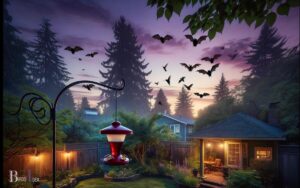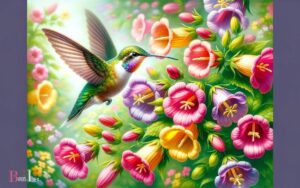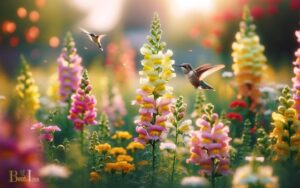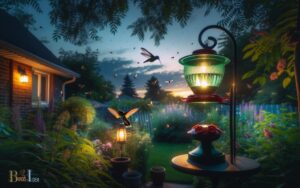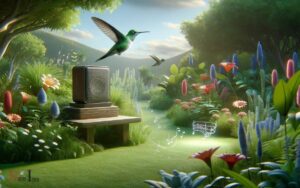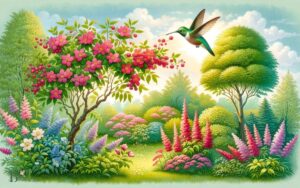What Type of Flower Attracts Hummingbirds? Bright Colors!
To attract hummingbirds, plant flowers that produce abundant nectar such as tubular-shaped blooms with vibrant colors.
Species like trumpet vine, salvia, bee balm, cardinal flower, and fuchsia are top picks. Additionally, native wildflowers are excellent choices as they’re well-suited to local hummingbird species.
Hummingbirds are attracted to flowers that offer ample nectar, which is their primary food source.
They are particularly drawn to blooms that are brightly colored, especially red, as well as those with a tubular shape that accommodates their long beaks.
Here are some key characteristics of hummingbird-friendly flowers:
Create a hummingbird haven in your garden by choosing nectar-rich blooms; their vivid hues and sweet offerings make your yard a favorite pitstop for these fluttering jewels.
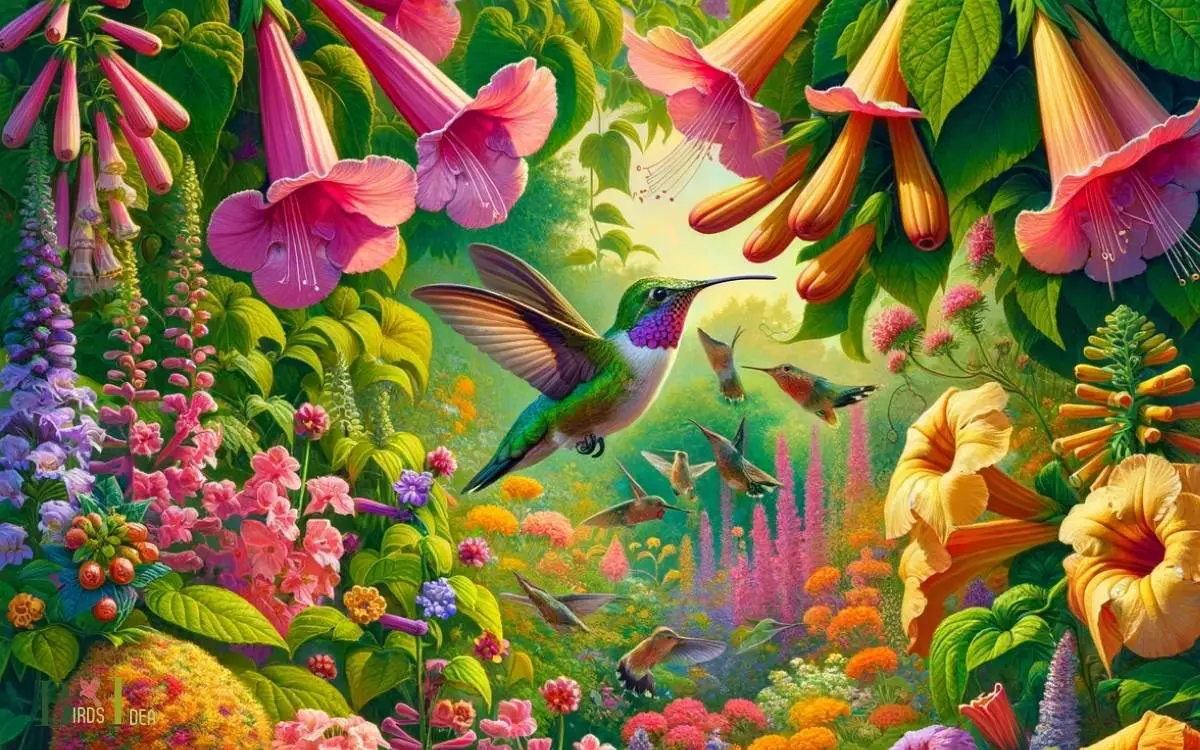
Key Takeaway
Understanding Hummingbird Behavior
One key behavior that attracts hummingbirds to certain flowers is their preference for nectar-producing blooms with bright, tubular shapes.
Hummingbirds have a unique ability to hover and extract nectar from flowers using their specialized, elongated bills and tongues.
They are attracted to bright colors, particularly red, as their vision is sensitive to shorter wavelengths.
Additionally, these birds are known to remember the locations of specific flowers and return to them, making the availability of nectar an essential factor.
Furthermore, hummingbirds are highly territorial and will often defend a productive food source, making the abundance of nectar in a particular area a crucial consideration.
Understanding these behaviors is fundamental in creating an environment that attracts and supports hummingbirds.
Characteristics of Hummingbird-Friendly Flowers
Hummingbirds are attracted to flowers with bright, tubular blooms that are rich in nectar. These flowers are often red or orange in color, which is visually appealing to hummingbirds.
Research has shown that these characteristics play a significant role in attracting and sustaining hummingbird populations.
Bright, Tubular Blooms
Bright, tubular blooms are essential for attracting hummingbirds to a garden or yard.
These specialized flowers have several key characteristics that make them particularly appealing to hummingbirds:
- Shape: The tubular shape of the blooms is perfectly suited for the long, slender beaks of hummingbirds. This allows the birds to easily access the nectar hidden within the depths of the flower.
- Color: Bright, vibrant colors such as red, orange, and pink are highly attractive to hummingbirds. These colors stand out and are easily visible to the birds as they flit from flower to flower.
- Nectar production: Hummingbird-friendly flowers produce ample amounts of nectar, which is a vital energy source for these high-energy birds. The abundance of nectar ensures that the flowers remain a valuable food source for visiting hummingbirds.
Rich in Nectar
Rich in nectar, these flowers provide essential sustenance for hummingbirds, ensuring a reliable food source for the high-energy birds as they visit the garden or yard.
Nectar is a primary energy source for hummingbirds, supplying the calories they need for their rapid metabolism.
Flowers rich in nectar often have tubular or funnel-shaped blooms that are well-adapted for the hummingbird’s long, specialized bill. Some examples of nectar-rich flowers include bee balm, trumpet vine, salvia, and penstemon.
These flowers typically produce abundant nectar, attracting hummingbirds with their high energy content.
Additionally, the sugar concentration of the nectar is crucial, as hummingbirds prefer nectar with a sugar content of around 20-25%.
This high-energy food source is vital for sustaining hummingbirds during their active foraging and flight. Transitioning to the subsequent section, red or orange flowers are particularly attractive to hummingbirds due to their coloration.
Red or Orange
Red or orange flowers are highly attractive to hummingbirds due to their vibrant coloration, which stands out amidst foliage.
Hummingbirds have an innate preference for these hues, as they associate them with an abundance of nectar.
The color red is particularly striking to hummingbirds because they have excellent color vision and are attracted to the longest wavelengths of light, which include red and orange.
From a scientific perspective, these colors are associated with high energy rewards in the form of nectar, making them evolutionarily advantageous for hummingbirds to seek out.
Additionally, red or orange flowers often have tubular shapes, which are well-suited to the long, specialized beaks of hummingbirds, allowing for easy access to the nectar within.
Best Flower Colors for Attracting Hummingbirds
Hummingbirds are attracted to bright, vivid blooms, particularly those in shades of red, orange, and pink.
These colors stand out to hummingbirds and are often associated with nectar-rich, tubular flowers that provide the energy they need.
Research has shown that these specific flower colors are most effective in capturing the attention of hummingbirds and encouraging them to feed.
Bright, Vivid Blooms
When selecting flowers to attract hummingbirds, gardeners should prioritize bright, vivid blooms that are rich in color and nectar. Hummingbirds are drawn to specific flower colors that stand out to them.
The best flower colors for attracting hummingbirds are:
- Red: Hummingbirds are highly attracted to red flowers, as they associate the color with a high nectar reward.
- Orange: Bright orange blooms, such as trumpet vine and honeysuckle, are also highly attractive to hummingbirds due to their vivid color and high nectar content.
- Pink: Flowers in shades of pink, particularly those with tubular shapes like penstemon and fuchsia, are favored by hummingbirds for their abundant nectar and visible, vibrant hues.
Gardeners can enhance their hummingbird-friendly gardens by incorporating flowers in these vibrant colors to create an inviting environment for these remarkable birds.
Red, Orange, Pink
Gardeners can enhance their hummingbird-friendly gardens by incorporating flowers in these vibrant colors to create an inviting environment for these remarkable birds.
When choosing flowers to attract hummingbirds, it’s essential to consider the color of the blooms.
Research indicates that hummingbirds are particularly drawn to red, orange, and pink flowers due to their highly visible nature and the abundance of nectar they provide.
These colors are known to stand out to hummingbirds, making it easier for them to locate a food source.
Below is a table showcasing some popular flower species that come in these attractive colors:
| Flower | Color |
|---|---|
| Bee Balm | Red |
| Trumpet Vine | Orange |
| Fuchsia | Pink |
| Salvia | Red |
| Zinnia | Orange |
Tubular, Nectar-Rich Flowers
Tubular, nectar-rich flowers are highly sought after by hummingbirds for their abundant nectar and distinctive shape. These flowers have evolved to attract hummingbirds with their specific characteristics.
When it comes to the best flower colors for attracting hummingbirds, the following stand out:
- Red: This color is a favorite of hummingbirds and is often associated with tubular flowers that produce high amounts of nectar.
- Orange: Similar to red, orange flowers are highly attractive to hummingbirds due to their rich nectar content and tubular shape.
- Pink: Some pink flowers, especially those with tubular shapes, can also be appealing to hummingbirds and provide a nectar source for these birds.
These colors, coupled with the tubular shape and nectar-rich content, make these flowers particularly attractive to hummingbirds, ensuring a beautiful and beneficial addition to any garden.
Native Flowers That Hummingbirds Love
The native flowers that hummingbirds love are typically bright and tubular, making them easy for hummingbirds to access.
Some popular native flowers include:
- The trumpet vine (Campsis radicans),
- Cardinal flower (Lobelia cardinalis),
- Columbine (Aquilegia canadensis).
These flowers have co-evolved with hummingbirds over time, developing traits that specifically attract these birds.
The trumpet vine, for example, produces an abundance of nectar within its long, tubular flowers, providing a rich food source for hummingbirds.
Similarly, the cardinal flower’s bright red blooms are tailored to catch the attention of hummingbirds, while the shape of the columbine’s flowers allows hummingbirds to easily insert their long bills and reach the nectar within.
Planting these native flowers can greatly enhance the presence of hummingbirds in a garden or natural habitat.
Long-Blooming Flowers to Entice Hummingbirds
Long-blooming flowers that entice hummingbirds are an excellent addition to any garden, offering sustained nectar sources for these tiny avian visitors.
When selecting long-blooming flowers to entice hummingbirds, consider the following options:
- Bee Balm (Monarda): This native perennial produces tubular flowers in vibrant shades of red, pink, and purple, providing a rich source of nectar for hummingbirds from mid-summer into early fall.
- Salvia (Salvia spp.): With its elongated, nectar-rich blooms, Salvia is a favorite of hummingbirds. It blooms continuously from late spring through fall, attracting these delightful birds throughout the warm months.
- Cardinal Flower (Lobelia cardinalis): This striking perennial produces tall spikes of bright red flowers, blooming from mid-summer to early fall, making it a valuable long-blooming resource for hummingbirds.
With these long-blooming flowers, it’s possible to provide sustained nectar sources for hummingbirds throughout the growing season.
Creating a Hummingbird-Friendly Garden
When selecting long-blooming flowers to entice hummingbirds, gardeners should also consider incorporating a variety of native plants and shrubs to create a hummingbird-friendly garden. Native plants provide natural nectar and attract more hummingbirds.
Here are some native plants and long-blooming flowers to consider for a hummingbird-friendly garden:
| Native Plants | Long-Blooming Flowers | Shrubs |
|---|---|---|
| Cardinal Flower | Bee Balm | Azaleas |
| Red Columbine | Penstemon | Weigela |
| Trumpet Vine | Salvia | Fuchsia |
These plants and flowers provide a continuous source of nectar and attract hummingbirds throughout the growing season.
By incorporating a variety of native plants, long-blooming flowers, and shrubs, gardeners can create an environment that is both visually appealing and attractive to hummingbirds.
Low-Maintenance Flowers for Hummingbird Gardens
To create a low-maintenance hummingbird garden, gardeners can incorporate hardy perennials and drought-tolerant flowers that provide a sustainable nectar source.
These low-maintenance flowers not only attract hummingbirds but also require minimal upkeep, making them ideal for busy gardeners.
Some excellent low-maintenance flowers for hummingbird gardens include:
- Bee Balm (Monarda): This hardy perennial produces vibrant flowers in shades of red, pink, and purple, and its tubular blooms are a favorite of hummingbirds.
- Salvia (Salvia spp.): With a wide range of colors and sizes, salvia is a versatile and low-maintenance option that provides abundant nectar for hummingbirds.
- Penstemon (Penstemon spp.): Known for its trumpet-shaped flowers, penstemon is a drought-tolerant perennial that blooms in various hues and attracts hummingbirds with its rich nectar source.
Seasonal Flower Varieties for Hummingbird Attraction
Seasonal flower varieties that attract hummingbirds include a diverse selection of nectar-rich blooms.
In spring, the trumpet-shaped flowers of columbines (Aquilegia) and the long, tubular blossoms of coral honeysuckle (Lonicera sempervirens) are highly attractive to hummingbirds.
During the summer, bee balms (Monarda) and cardinal flowers (Lobelia cardinalis) are popular choices due to their rich nectar content and vibrant colors.
In the fall, salvias such as autumn sage (Salvia greggii) and pineapple sage (Salvia elegans) provide a late-season food source for hummingbirds preparing for migration.
It is important to consider the specific blooming periods of these seasonal varieties to ensure a continuous nectar supply for hummingbirds throughout the year.
By incorporating these seasonal flower varieties, one can create a garden that consistently attracts and supports these delightful avian visitors.
Conclusion
Attracting hummingbirds to your garden can be achieved by planting native flowers with long-blooming periods in a variety of colors such as red, orange, and pink.
These flowers should be low-maintenance and seasonally diverse to provide a continuous food source for the hummingbirds.
Like a colorful tapestry woven with delicate precision, a garden filled with these hummingbird-friendly flowers will surely enchant and delight both the birds and the observer.

